November 04, 2010
Explore the West's scenic riverbottoms for old bottles and big whitetail bucks!
By Brandon Ray
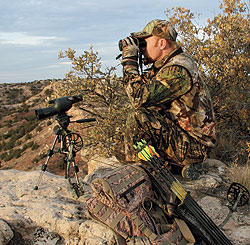
Advertisement
Glassing from a distance is the key to monitoring riverbottom bucks without putting too much pressure on them. |
Advertisement
The buck's massive, dark antlers were as unmistakable as a name tag. I recognized him instantly. Multiple times over the previous weeks I'd spied on him through a giant spotting scope lens from a distant mesa, carefully planning my next move and waiting for a southwest wind so I could take my spot in a strategically-placed natural ground blind.
Now the buck stood inside of 20 yards, sniffing a doe in the fading afternoon light. The climax of our season-long chess match was about to unfold.
When my arrow whistled through the buck's chest, he flinched and trotted 60 yards before sagging to the earth, the air exhausted from his lungs. It was all over in seconds.
Holding his antlers for the first time, I was awestruck. A 150-class eight-point is a rare critter indeed. As I rolled him over for the field-dressing chores, something in the sandy red river soil shined in the slanting light of the sunset. Just a few steps away from the dead buck rested a half-buried bottle, maybe a lost artifact from some pioneer. I'd found the remains of an old covered wagon, rusted pocketknives, bullet casings, and arrowheads on the same ranch. On a neighboring property, a rancher had uncovered a petrified bison skull from a big bull -- probably hundreds of years old. Western history runs rich in this soil.
Unearthing my second prize of the evening, I brushed the dirt off the antique whiskey jug. It was in perfect condition, without a scratch. That night, I packed a very special buck and an old brown bottle off that sandbar.
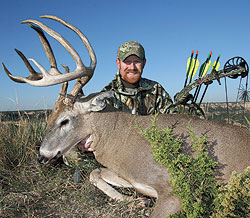
I shot this long-tined nine-pointer in 2007. The big buck's rack measured 157 inches. |
Today the brown jug sits on my kitchen counter. Every evening I drop my pocket change into it -- the poor man's way of saving for his daughter's college education. And every time I make a deposit in the poor man's bank, I think of two things; first of the special buck that led me to that bottle, and then, when reality sets in, of the enormity of saving for my kid's future. It's gonna take a lot of quarters to pay for Emma's higher education!
Western Whitetails
Western riverbottoms have served as important travel corridors for hundreds, if not thousands, of years. Water was the obvious attraction to native Indians, explorers, and pioneers because of its scarcity beyond well-known river and creek basins, but the shade of towering cottonwoods and plentiful wildlife were probably equal attractions. This is probably especially so in arid parts of the West, where river corridors are like oases for wild game, even today.
I'm far from being the first one to discover Western whitetails. On their epic journey across the West, from 1804-1806, Meriwether Lewis and William Clark kept detailed notes on the flora and fauna they discovered during their adventures. Their notes included comments on such diverse animals as whistling swans, bison, elk, porcupines, mule deer, and yes, even whitetail deer. The following quote relates to whitetails.
"By 10 a.m. they had all returned to camp having killed seven deer. These were all of the common fallow deer with the long tail. I measured the tail of one of these bucks which was upwards of 17 inches long." -- Meriwether Lewis.
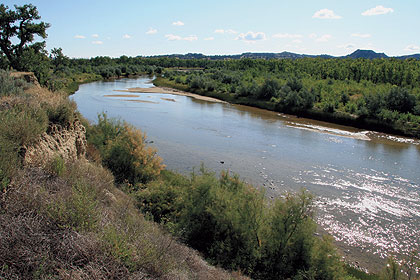
Western rivers like this are home to quality whitetails seeking shade under tall cottonwoods and around dense willows bordering agriculture. |
Today, numerous Western states offer good hunting for whitetails. I've had good hunts in the Texas Panhandle, the eastern plains of Colorado, and the southeastern prairies of Montana. Other locations worth investigating include Wyoming, Idaho, Kansas, Nebraska, South Dakota, Canada's western provinces, and others.
Hunting Western Bucks
Today, there are dozens of states with good whitetail hunting. So why hunt out West?
Western whitetail hunting offers a few clear advantages over hunting deer in other places.
Three things excite me about these whitetail bucks:
1. Visibility. Whitetails here are vulnerable because you can see them. In my experience, hunting popular deer country in the East can be maddening. The woods are so thick, unless a buck is 20 yards away, you can't see him. Western whitetail habitat is different.
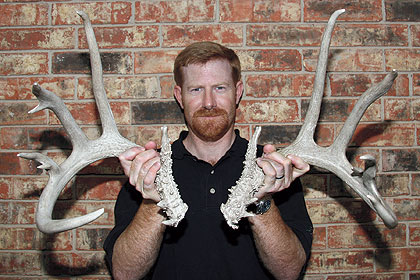
Sheds like this are proof positive that Western riverbottoms can, and do, produce big bucks. |
Bucks found in the croplands and prairies outside of their narrow ribbon of riverine habitat, often consisting mainly of willows and cottonwoods, are easily observed.
Western rivers many times sweep through broad basins, canyons, and prairies. Here it's possible to spy on bucks from distant high ground -- and sometimes even from the window of your truck. Decode a buck's travel patterns and you can move in and set up a stand. Western whitetails usually congregate near agricultural food sources such as wheat, milo, or alfalfa. Find these areas, and you'll find deer.
2. Solitude. The best hunting on Western riverbottoms is often miles from any sort of civilization. Compared to big-city bucks in crowded suburbs, Western whitetails receive far less hunting pressure. That's always a good thing. In my experience, Western bucks are more visible in daylight hours. And out West, believe it or not, it's still possible to knock on a rancher's door and get permission to hunt. They won't always let you hunt, but enough do to make it worth trying.
3. One Buck. That combination of a buck's visibility in the open terrain and minimal hunting pressure also makes targeting one specific buck a real possibility. Once you've patterned him, whether he enters a crop field through the same gap in a fence each evening or has some other chink in his armor, if you put that knowledge to good use, you might get multip
le chances at Mr. Big. Only hunt when the wind is right. Be cautious about your entry and exit, and don't over-hunt the area. If hunting pressure is light -- and the buck stays visible -- you can even fine-tune your stand or blind position.
So, how good can it be? Bucks with antlers from 130-150 inches are certainly attainable.
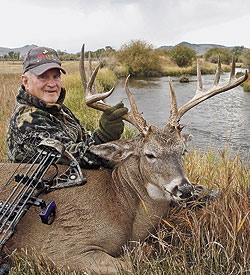
Don Dvoroznak took this 168-inch Montana buck in late September 2007. The Dvoroznaks shoot many of their best bucks this time of year. |
I've killed a couple bigger. And some true giants are living secret lives out West. I've held a set of long-tined, matching sheds that would give even Milo Hansen the shakes.
They came from the banks of a lonely creek bottom. Given a conservative spread, the buck's rack easily would net 200 typical inches. That buck is crazy big, and he's still alive, so I'm sworn to secrecy on exactly where I saw his drops.
Montana Pros
The father-and-son team of Don and Keith Dvoroznak of Ripcord Arrow Rests are the real deal when it comes to Western whitetails. Don and Keith know hunting Western whitetails has its advantages over hunting deer in other places. Every year these two archers tag dandy bucks in their home state of Montana. So I asked Keith how they do it.
"The way we hunt whitetails is to find the food source, which in our area is alfalfa," Keith said. "From a distance, we start watching the fields at the end of July and keep watching them all the way to the end of August. By doing this, we pretty much know the bucks and start to bear-down on the patterns of the shooter bucks we've put on our hit list. Usually by the middle of August, what you see in terms of antler growth is what you're going to get for the year. Also, this is when we start hanging our stands. Midday seems to be the best time to hang stands because most of the deer have left the fields for the shade of the willows and cottonwoods. Our stand locations are on the edges of fields and sometimes in lone trees out in the fields. Wherever we see a shooter entering a field or walking by a single tree, we'll get a treestand in place. We like to hang our stands in the middle of August, which is about three weeks before opening day here. Then we get out of there and go back to long-range surveillance.
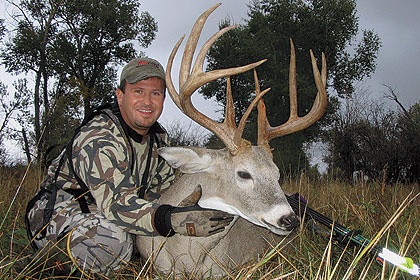
Keith Dvoroznak shot this 189-inch Montana 11-pointer in late September 2007. |
"Once the season starts, we often will sit in stand locations that we've set primarily as observation posts. They may not be hot stands, but they'll allow us to watch deer at a closer distance and to really pinpoint a shooter buck's entry trail to the food source. That way, if we need to fine-tune a stand we can, or if we did our homework and we have the stand in the right place and the deer are comfortable with their approach to the food source, we will move in and wait for our chance.
"I know this might sound crazy, and you might think the high-mountain air has made us nuts, but we sit all day in September, sometimes in 90-degree temperatures. Why? Well, because deer often will come and go between the cover and fields, and by getting down from your stand you can spook deer that you can't see. For that reason we prefer all-day sits, and they have worked for us more times than not. Plus, I can't think of a better way to spend my free time than sitting in a treestand waiting for a big whitetail buck!"
I follow some of the same rules used by the Dvoroznaks. I use big optics to scout my backyard riverbottoms from canyon rims. I'm usually one mile or more away. I can inventory bucks without their knowing I'm watching them, and I can move in when I see a pattern and have a plan. The less time I spend actually in a tree or ground blind near the river, the better I like my chances. Based on my experience, spending too much time in those wild places will pollute things.
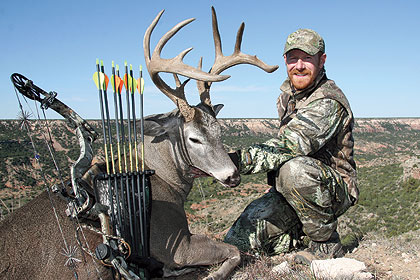
I shot this dandy 11-pointer in 2008 from a natural ground blind near a Texas Panhandle river. |
My 2008 River Treasure
Last year I found a buck worth hunting in the Texas Panhandle. Spying from a mile away with a spotting scope, I recognized him from the year before. Split brow tines and drooping main beams distinguished him from others. In 2008, he added mass to his beams. He routinely traveled through a cedar-crowded ravine near the banks of the river.
This was the chink in his armor. The hunt was on.
On October 23, I hiked into the canyon to sit in a ground blind, a shadowy spot under the sagging limbs of a big cedar tree. Late in the evening, my target buck strolled within range, accompanied by an ancient seven-pointer. The split-brow-tine buck was a dandy, with probably 140-ish antlers, but the season was young. What else was out there? I couldn't make up my mind. The buck walked out of range. As he disappeared, I scolded myself. Who passes a buck like that at 20 yards? I thought. It was a long hike in the dark back to my truck.
The following day I regretted my decision. So I made the hike to the river again for an evening rematch. This time I knew I'd shoot if given the chance.
At sunset, the same split-brow-tine buck strolled through the cedars and passed at 25 yards. My arrow laced both lungs and the buck galloped 100 yards and then teetered on his side. He was the only deer I saw that afternoon. Lifting his antlers out of the sandy riverbottom, I gave thanks. I was all alone with my thoughts.
I wondered what it would have been like to hunt these riverbottom bucks 200 years earlier. Did the likes of Lewis and Clark kill bucks with antlers as big? If so, did they even bother to keep them? Could herds of bison be seen and heard in the prairies surrounding the whitetail's hollowed riverbottom habitat?
By the time I dragged my weary body home, it was after midnight. Stripping out of my dirty hunting clothes at the back door, I started to empty my pockets. The old brown jug on the kitchen counter was staring at me.
I dropped a fistful of change into the bank. First, I thought of the hundred more handfuls of nickels and dimes I'll have to deposit to send my girl to college. Stress started to infect my tired body. But then I remembered the big eight-point that led me to the brown jug years earlier. And the handsome 11-point that was now hanging in the barn. In between, there were other fine hunts in the same riverbottom soil so rich in history. A place where treasures, whether they're old bottles or big whitetail bucks, are waiting to be discove
red.
The author is a well-known outdoor writer and photographer from Amarillo, Texas.
Author's Notes: My 2008 gear included a Diamond Marquis bow set at 61 lbs., Gold Tip Pro Hunter 5575 shafts, 100-grain G5 Montec broadheads, Sonoran sight, Doinker stabilizer, and a Trophy Ridge Drop Zone rest.
